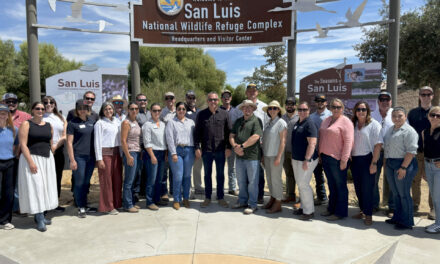Recently, the U.S. Bureau of Reclamation announced its initial allocations for Central Valley Project water users. This is always big news in the water world, but for those of you who are not tuning in to listen to the Bureau of Reclamation’s press conferences let me explain why this matters and how it likely impacts you.
For decades, the Central Valley was able to rely on dependable water supplies that provided the region with sufficient resources to grow the food and other crops that supply the rest of the state and much of the nation.
While there have been droughts before, climate change and new state and federal regulations have had a major impact on the region in recent years, resulting in a prolonged drought.
This has caused decreased water flows throughout the state, including the Sacramento, American, Feather, and San Joaquin Rivers, which impacts our organization, the San Joaquin Rivers Exchange Contractors Water Authority, and our neighbors.
The original agreements that allowed the Central Valley Project to move forward led to the Central Valley becoming the most important agricultural region in the country. Today, the Exchange Contractors provide or convey water to other local agencies and a large percentage of local wildlife and refuge areas.
The Exchange Contractors’ conservation and groundwater management efforts help make it possible for the Exchange Contractors to continue supplying other local areas.
In recent years, we have received only 75 percent of our typical allotted water distribution and other regions have faced even more severe cuts to their water allocations. What is really challenging is that the reliability of these water allocations swings wildly from year to year.
While it is true that the annual average water allocation has been almost cut in half since 1978, that figure is just an average. In reality, the allocations vary greatly from year to year with little predictability about what the following year will look like.
This instability makes it difficult for growers to plan ahead for expansion or future yields. It makes it challenging for wildlife refuges that depend on CVP water as an important source to maintain the ecological health of their regions. And it causes uncertainty for cities and disadvantaged communities, as well as countless water users in the region.
We have seen some major storms and heavy rain to start this year, and as a result our organization is fortunate to receive our full initial allocation. However, many of our neighbors and partners have received reduced allocations, a situation we hope will improve.
Their reduced allocations only continue to highlight the urgency behind developing new water infrastructure projects to capture, store, and replenish water to meet the needs of water users throughout the state.
The Exchange Contractors are advancing a number of efforts to enhance our region’s capacity and sustainability. These include the Del Puerto Canyon Reservoir Project, the Orestimba Creek Recharge and Recovery Project, and a series of projects on Los Banos Creek.
Additionally, we are actively working with the Bureau of Reclamation and partner agencies to further strengthen our water systems. This includes ongoing efforts on a south-of-Delta drought year pilot plan for which our agency and others will reserve allocated water for future use in dry years.
The Exchange Contractors have long been at the forefront of conservation and sustainability efforts in our region, and we will continue to invest heavily to be able to meet both the agricultural needs of our region and the needs of surrounding communities.

